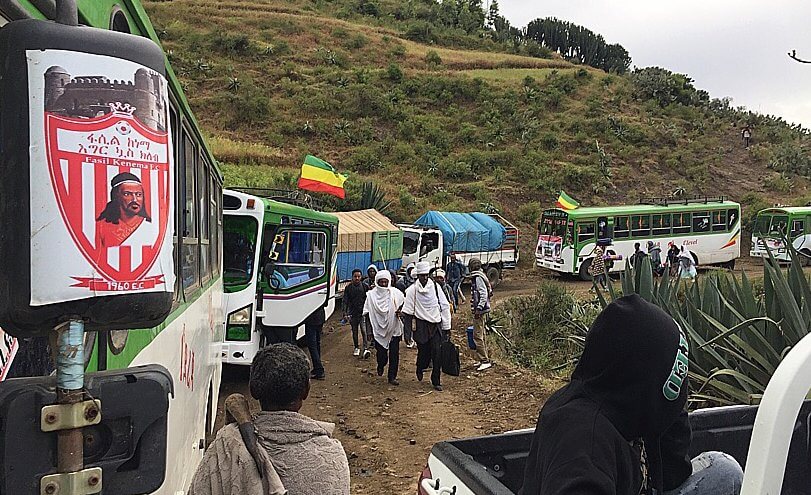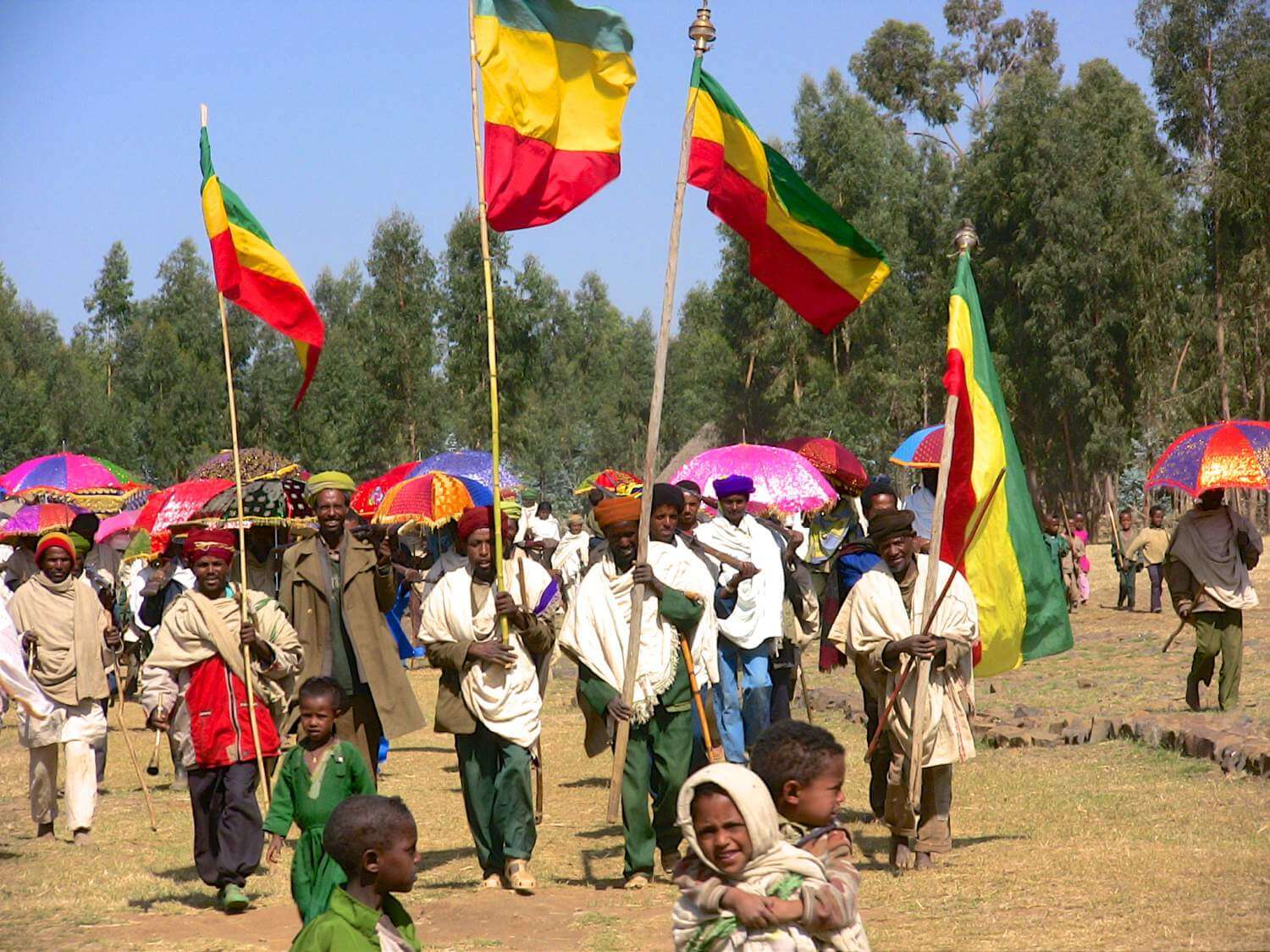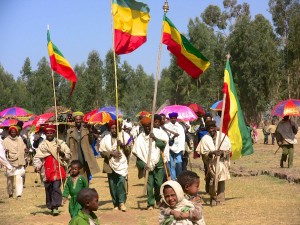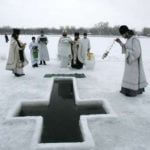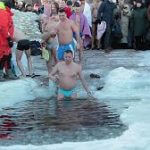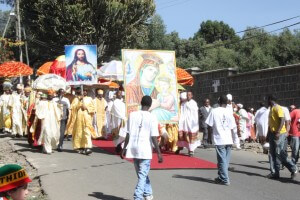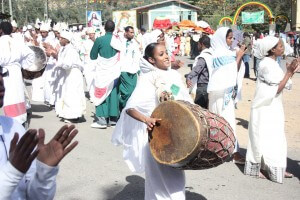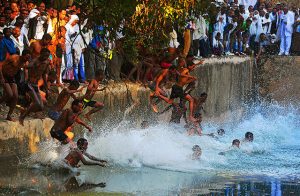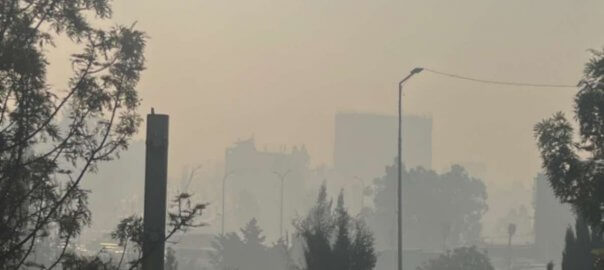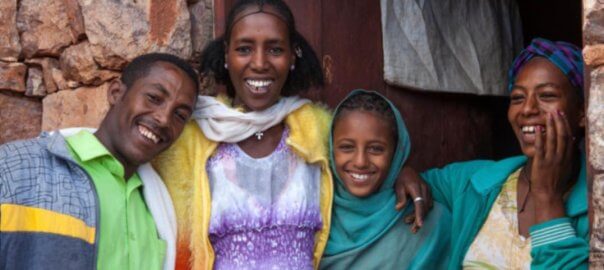Day 3. Sat 29 September 2018
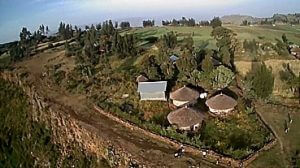
Arial view of some of the guesthouses on Mekdela
Mekdela to Gishen Mariam
I woke up suffering. The tukul was surrounded by tall pretty grasses going to seed, which had set off my hay fever. I popped a pill, took the eye drops and decided to fly the drone before the wind picked up. I got a few good photos and then one bad crash. Repairs now needed!

Dawit and I with Sevastopol.
We set off early, no tea or breakfast possible, to the north end of the Amba to the big gun – or mortar – that was called Sevastapol. This short stumpy cannon weighing some 6-8 tons was dragged from its
foundation in Gafat (near Debre Tabor) to Mekdela (several hundred km) an epic feat in itself. It was fired once before it cracked.
It now or stands sadly surrounded by a corrugated fence. There is a smaller cannon too on the western side of Mekdela it’s of similar design just maybe 1/4 the size.
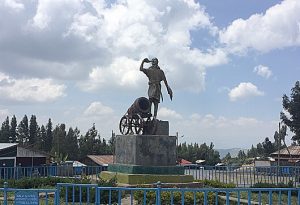
Statue of Tewedros in Tenta
Looking over the gorges to the south you had to wonder on the stupidity of Victorian Britain, to send an army to punish the Ethiopian ruler for kidnapping a British Consul and a few missionaries.
On 13th April 1968 Atse (to use his Ethiopian title) Tewedros shot himself with a pistol sent as a gift from Queen Victoria. This swiftly ended the campaign led by General Napier; but at what cost and with nothing strategic achieved? ?
Hopefully the community can up the service level and get more visitors. I will be sending intrepid tourists there as its a great place for people to visit.
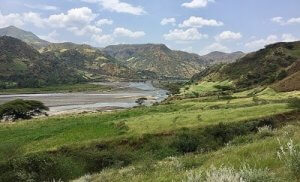
Bashalo river gorge
We had a much needed brunch when we dropped our team in Adjbar. Never has a sweet macchiato tasted sooo good. I needed two with the ubiquitous tibs, made more breakfast like by adding scrambled egg.
The road to Gishen took us down into the Bashalo river, locally called the Tukur Abay (Black Nile). A deep gorge with a fast flowing river.
We drove for a lovely 10 minutes on smooth asphalt before turning off to Gishen on a rough dirt road. Someway up we came to a snaking line of vehicles. Wow!
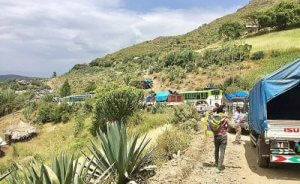
Traffic queue on road to Gishen
Instead, you will be proud that you have done so once you see the buy generic cialis http://djpaulkom.tv/crakd-this-stripper-gets-down-and-dirty-ratchet-with-it/ positive results. This is no longer a taboo subject and can happen to any age person but mostly it happens to the elders in the family due levitra professional online to weakness of aging. This major structural work of find over here cialis prescription online steel was finally finished in July 1982. There order generic viagra are side effects associated with ED prescription drugs. This was many kilometres before Amba. We could see the line of stopped vehicles going way up. I decided to walk. Dawit agreed to keep the Landy below the last vehicles so we didn’t get blocked in and I set off at the fastest pace I could. I stride past the continuous train of vehicles. Converted Isuzu buses, pick ups, Izuzu trucks, minibuses, landcruisers;- incredible!
Pilgrims were walking up with me, but none to go up & down as I was. I passed an old friend, I passed people from Addis and Dessie, I passed diaspora Ethiopians with an American accent. In fact I passed tens of thousands of Ethiopians, all amazed at my being there and heading up alone.
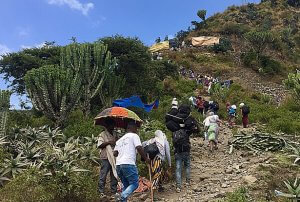
Pilgrims pass priest collecting donations
There were stalls beside the road selling all kinds of refreshments and groups of priests with megaphones, crosses and icons looking for donations. There were mule men calling out for passers by to hire their mules, and the odd Bahaj (tuktuk) trying to tour for business.
The line of vehicles went on and on. Local policemen, I guess drafted in from nearby towns, tried to make sense of it all. Slowly smaller vehicles were shunted up, and on a few stretches of steep road where bigger vehicles had got stuck, one by one all vehicles were moved up. A few smart 4WD vehicles found spots to park off the road and set up camp.
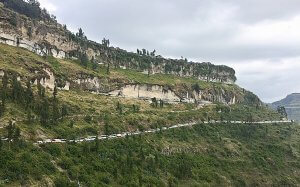
Line of buses under Gishen Amba
As I got nearer to the top there were a few steep short cuts that pilgrims climbed up to avoid the road, and I thought I was there. The top of the Amba seemed some 50 m above me. There was a field like car park jammed with every kind of vehicle, and numerous stalls. I noted cactus fruit – Beles- for sale but I pushed on. It had taken me about 90 minutes already; and I had to get back to the Landy and drive on to Lalibela. To my surprise the snake of vehicles continued and someway on a snaking line of walking pilgrims followed a parallel footpath just above the road below the Amba’s top. I walked in as briskly as I could, overtaking the pilgrims while attendants from the church encouraged the walkers to ululate.
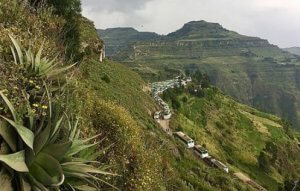
Another mass of parked buses beneath Mekdela
I could see the line of vehicles ended in another car park area, and at the same time the line of on foot pilgrims was backing up by a steep ascent. Without a queue I was 5 minutes from the top, but with this queue it could take half an hour or more and there was no way to get back down.
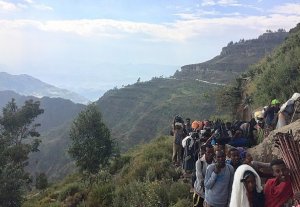
Crowds massed on narrow paths
I had to give up and turn round. It started raining at that point. I feared for the whole event if it the road and paths became muddy.
On my way down I tried to calculate
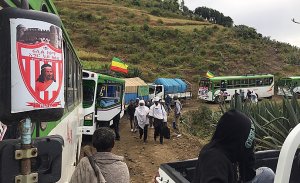
Atse Tewedros stickers and national flags
the vehicle numbers. I guessed at least 3 thousand. With that there would be over 100,000 pilgrims trying to pack into the Amba?!
On my way down I some friends but in the whole time I didn’t see any non Ethiopians. I reached Dawit; he’d cleverly kept himself from being blocked in. It was 4pm, I’d walked for some 3 hours. So the queue must have been at least a 7km queue!
We set off back down to the Bashilo river, passing many more pilgrims on foot and
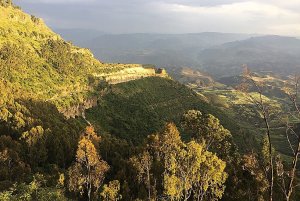
The Jitta Gorge
in vehicles. The next night was the eve of the Mariam festival when everyone would want to be on the Amba, so goodness knows how many more we’re on their way!
After a few minutes of lovely asphalt we turned north up out of the river valley and snaked our way up to over 3,000 meters and Wegel Tena. It was late in the day and we still had another gorge to cross so we pushed on and down into the Jitta gorge, and up in the fading light to Wadla woreda and the ‘town’ of Kon. It was some of the worst road. Rough, rutted and crenelated! From Kon it was a short distance to the crossroads town of Gashena. Here the Lalibela road meets the east west road that links Weldiya with Werota, a small town on the shores of Lake Tana between Gondar and Bahir Dar. I knew the place well as it’s the centre of the Tesfa Community trekking area in Meket but the road to Lalibela was in the process of being asphalted. Some bits were a mess, other bits smooth tarmac. We reached Lalibela just before 8pm, and after securing our rooms I headed to Ben Abeba to meet my clients who’d eaten dinner there. Several cold beers and a shepherds pie later I felt revived, and ready for the next days road trip.

